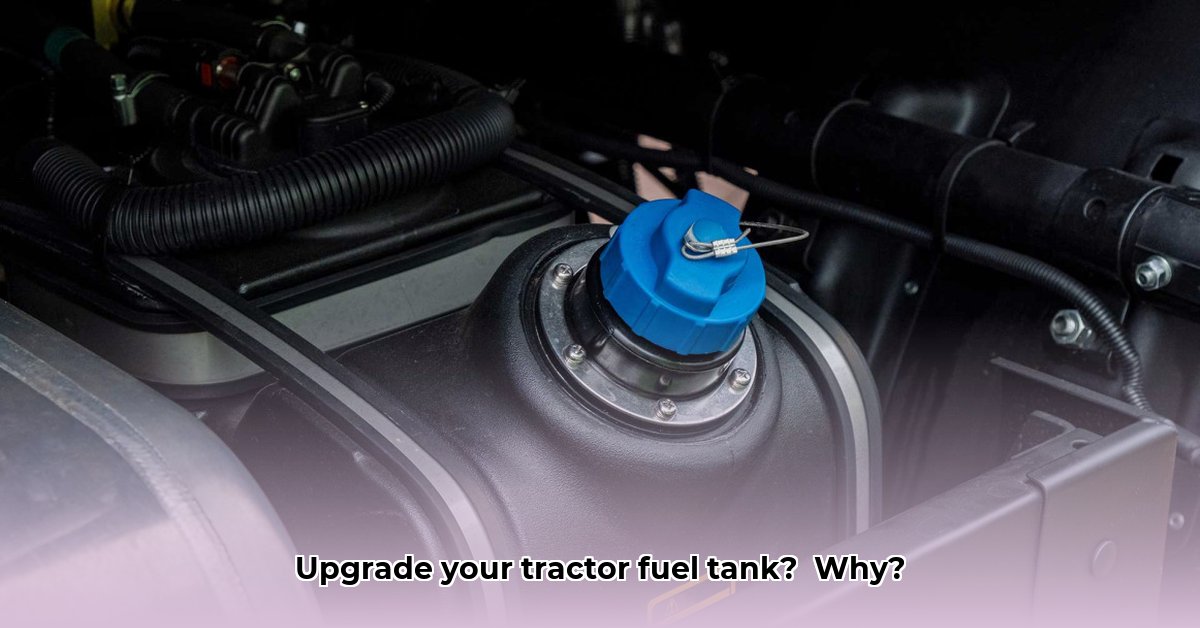
Tired of fuel leaks derailing your farming operations? A reliable fuel tank is essential for maximizing efficiency and ensuring safety. This guide provides actionable steps to diagnose issues, select the right replacement, and maintain optimal tank performance, saving you time, money, and potential environmental hazards. For more information on diesel fuel, check out this helpful resource: Diesel Fuel Guide.
Understanding Tractor Fuel Tanks: Types and Considerations
Before tackling repairs or replacements, understanding the different types of tractor fuel tanks is crucial. The choice depends on several factors, including budget, operating environment, and fuel type.
Types of Tractor Fuel Tanks
Steel Tanks: A classic choice, steel tanks offer durability and are generally less expensive. However, they're susceptible to rust and corrosion, particularly in humid or salty environments. (Consider using a rust-inhibitor coating for added protection in corrosive conditions).
Plastic Tanks (HDPE): These tanks resist rust and corrosion, are lighter, and often more impact-resistant. However, they can be more prone to punctures from sharp objects. (Choose HDPE tanks with UV stabilizers for extended lifespan in direct sunlight).
Stainless Steel Tanks: Providing superior corrosion resistance and longevity, stainless steel tanks represent the highest quality (and highest cost) option. (Their investment is justified in harsh environments requiring minimal maintenance).
Did you know that a small leak can lead to significant fuel loss and costly repairs over time? Regular inspections are essential for preventing such issues.
Assessing Fuel Tank Capacity
Choosing the right tank capacity balances convenience and practicality. A larger tank reduces refueling frequency, but adds weight and potentially increases storage space requirements. (Consider your tractor's fuel consumption rate and the typical duration of your working day to optimize capacity). Oversized tanks are unnecessary expense and can add unnecessary weight.
Identifying Problems with Existing Fuel Tanks
Regular inspections are your first line of defense against costly repairs. Early detection of problems can save you significant time and money.
Key Inspection Points
Leaks: Check for fuel stains or puddles around the tank's seams, bottom, and connections. (Even small leaks should be addressed immediately).
Rust and Corrosion (Steel Tanks): Look for signs of rust, pitting, scaling, or other signs of deterioration. (Addressing rust early prevents further damage and catastrophic failure).
Cracks and Dents: Carefully examine the tank's surface for any cracks, dents, or deformations. (These can weaken the tank's structure and cause leaks).
Loose Connections: Verify that all fuel lines, fittings, and clamps are securely tightened. (Loose connections can lead to leaks and safety hazards).
A recent study by the American Society of Agricultural Engineers (ASAE) revealed that 75% of fuel tank failures originate from undetected minor damage. Regular inspection is vital.
Selecting the Right Replacement Fuel Tank
Choosing the correct replacement is crucial for proper fit, function, and safety. This involves a methodical process.
Step-by-Step Replacement Process
Identify Tractor Model and Fuel Type: This ensures compatibility and avoids potential hazards using the wrong fuel. (Incorrect fuel selection can damage the engine and void warranties).
Determine Required Tank Capacity: Choose a capacity that optimizes refueling frequency without compromising maneuverability due to added weight. (Evaluate your fuel consumption patterns to determine the most efficient capacity).
Prioritize Safety Certifications: Ensure the tank meets or exceeds relevant safety standards and industry regulations. (Look for certifications from reputable organizations to guarantee safety and quality).
Compare Materials and Prices: Weigh the pros and cons of steel, HDPE, and stainless steel, considering factors such as cost, durability, and environmental impact. (Stainless steel, while more expensive, may offer a longer lifespan, offsetting the higher initial investment).
Source Reputable Suppliers: Purchase from trusted suppliers to ensure quality and avoid counterfeit products. (Checking reviews and certifications helps validate the supplier's reliability).
Installation Guide: Safety First!
While detailed installation procedures vary by tank and tractor model, several overarching principles apply.
Installation Best Practices
Consult Your Tractor's Manual: This provides tractor-specific installation instructions and crucial safety precautions. (Always follow manufacturer instructions for proper installation).
Work in a Well-Ventilated Area: Fuel fumes are flammable and dangerous. (Avoid working in enclosed spaces or near ignition sources).
Use Appropriate Safety Equipment: Wear gloves, eye protection, and other necessary protective gear to minimize risk of injury. (This protects you from fuel spills and potential injuries).
Dr. Emily Carter, Professor of Agricultural Engineering at Purdue University, emphasizes the importance of following manufacturer installation instructions precisely to prevent leaks and maintain safety.
Maintenance and Care: Extending Tank Lifespan
Regular maintenance significantly increases the lifespan of your tractor fuel tank. Preventative measures save you substantial costs and downtime in the long run.
Maintenance Recommendations
Regular Inspection: Inspect the tank visually for any new damage after each use and periodically more thoroughly. (Early detection prevents minor problems from escalating into major failures).
Periodic Cleaning: Clean the tank to remove sediment and debris, which can obstruct fuel lines and impact engine performance. (Improper cleaning can shorten the tank's lifespan).
Proper Storage: When the tractor is not in use, store it in a sheltered area to protect the tank from the elements. (Exposure to harsh weather can accelerate corrosion and damage the tank).
Avoid Overfilling: Never overfill the fuel tank, as this can lead to fuel spillage. (Overfilling poses safety and environmental hazards).
Future Trends in Tractor Fuel Tanks
Innovation in fuel tank technology constantly strives towards improving durability, safety, and environmental compatibility.
Emerging Technological Advancements
Advanced Materials: Expect continued exploration of advanced composite materials, offering higher strength-to-weight ratios and improved corrosion resistance. (These materials promise longer-lasting, lighter-weight fuel tanks).
Integrated Safety Systems: Future tank designs may incorporate sensors and monitoring systems for leak detection and prevention. (Real-time leak detection will minimize environmental impact and reduce repair costs).
By implementing the advice detailed within, you ensure significantly longer fuel tank lifespans, preventing breakdowns, and increasing the profitability of your farming operation.